Have you ever been to a museum in a particularly boring exhibit of random dishes and watched people look at the artwork and wondering what in the world they find so interesting about something you think is so boring? I have to admit I’ve been there–watching people looking intrigued wondering if they are faking it. As I continue my journey of exploring more art from around the world (watch last week’s Facebook Live for more information about this journey), this is happening less and less for me.
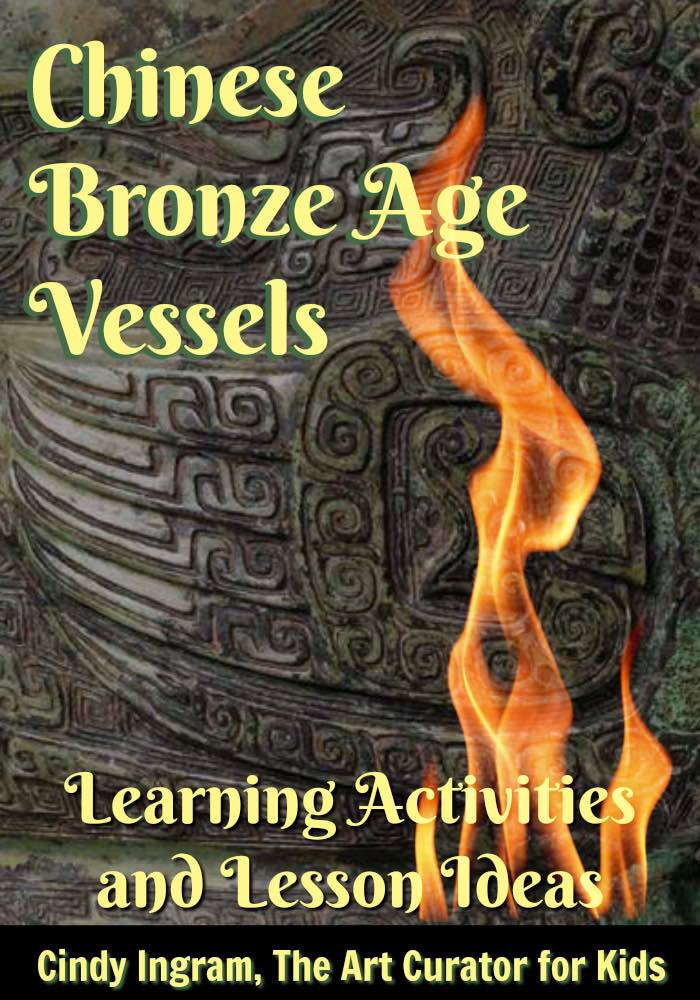
In today’s post, we’re headed to Bronze Age China, from about 1700 BCE to about 200 BCE, where we will be inspired by some pretty awesome bronze vessels. They may not look that exciting at first glance, but the more you look at them, the more cool stuff you will find.
Prehistoric Chinese Art
To give you some context, I’m going to share with you a little bit of information about the artworks that came before so that you can get a better understanding of Ancient Chinese art as a whole. The earliest art from the Neolithic Period in China was clay pots and pottery.

These clay pots from the Neolithic time period had animal designs and human faces. They eventually ended up making those animals into more symmetrical, abstract shapes, and we’re going to see that transfer over to the Bronze Age art we will look at below.

Another important art form from Ancient China that dates all the way back to 3,800 BCE is jade sculpture and ornaments. Out of jade, they made cylinders, discs, pendants, jewelry, hair ornaments, plaques, and sculpture.

Jade in China comes from a mountaintop. When it falls down into the river it breaks open and reveals this beautiful green underneath. It’s become a signifier of Chinese art, even still today.

Back in ancient times, the rulers and the noble people wore the jade in their tombs which showed the importance and the value of these jade ornaments. They also believed that the jade could protect your body from decaying in the tomb and that would help you on in the afterlife.
Chinese Dynasties
When studying Chinese art history, it’s important to understand their social structure and their governmental structure, because that is what has remained consistent over a really long period of time. China has, for the most part, always been run by dynasties. A dynasty is a group of kings, so one dynasty would be one guy who starts the dynasty as the first ruler of that dynasty. He has a son which then becomes emperor. That boy would have a son. Then that man has a son. Then that would continue until the end when there would be no sons left. Then a new dynasty would emerge as the ruler. Most of Chinese history has been run in these dynasties. A dynasty can run anywhere from ten years to several hundred years depending on the longevity of that group.
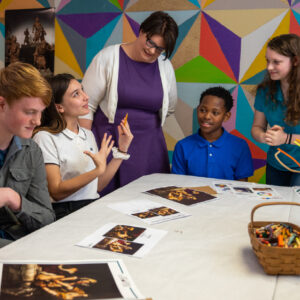
Get the Full Lesson!
This Lesson is in The Curated Connections Library!
Find the full lesson from this post along with hundreds of other art teaching resources and trainings in the Curated Connections Library. Click here for more information about how to join or enter your email below for a free SPARKworks lesson from the membership!
Chinese Bronze Vessels
Scroll through this slideshow to see examples of Chinese Bronze Vessels.
[slideshow_deploy id=’10679′]
Function of Bronze Vessels
The Bronze Age begins at the end of the Shah dynasty and the beginning of the Shang dynasty. During the Bronze Age, in addition to tools and weaponry, we begin to see a bunch of bronze vessels from Ancient China.
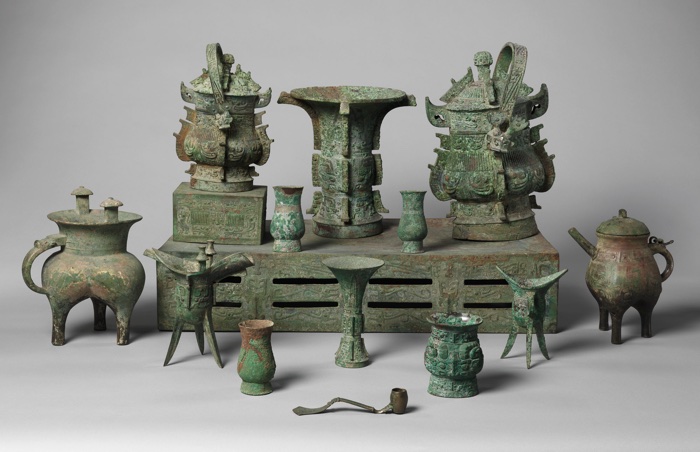
These vessels are more than just to serve and store food. These vessels have a very sacred and spiritual purpose. An important person might own a bronze vessel, and they use that bronze vessel in rituals to celebrate and to honor his or her ancestors. Then, when that owner of that vessel passes on, the vessel then is included in the tomb of that important person.
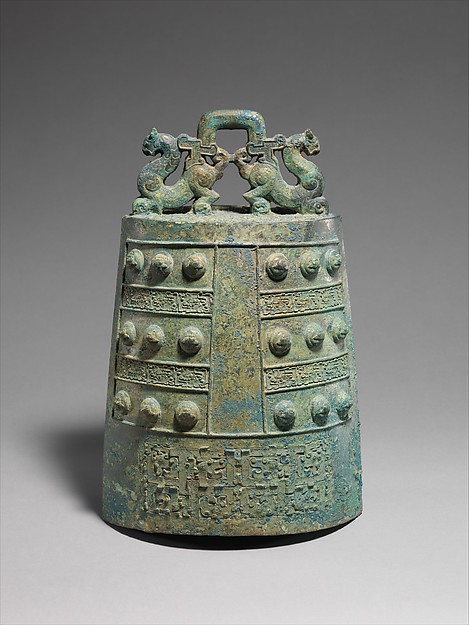
There have been cases of over 200 pieces of bronze vessels in one royal tomb. Bronze vessels started out as a very ritualistic and spiritual thing and, as they became more common, they started to be used more for practical purposes and for aesthetic enjoyment as well.
There are a lot of different types of bronze vessels. Two types are the zun and the ding. A zun holds wine, and a ding is used to cook and store meat.
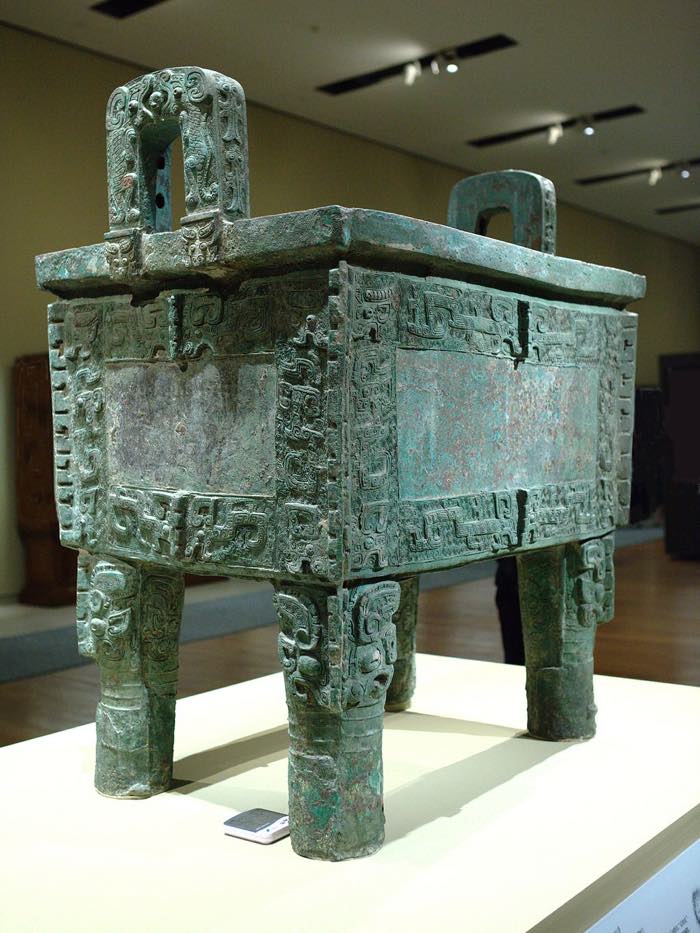
The larger the ding is–the more important and more powerful the person is who owned it.
Chinese Bronze Casting Process
These bronze vessels were created using a process called piece mold casting. Piece mold casting is kind of a longer and more complicated process that the more common lost wax casting. It’s more challenging of a process but it allows the artists to create these really cool designs on the outside of their vessels.
With piece mold casting, they would make a model of what they wanted the vessel to look like at the end. Then, they would create a mold of it with clay along the outside. Once that clay mold was created, then they cut apart that mold into pieces and then put it back together before they poured the bronze in. If it was a vessel, they would have to put in some sort of cavity on the inside so that it would have the hole, and it wouldn’t be solid. It was harder to do than lost wax casting–more bulky and less fluid of a process. But once they had those pieces broken away, they could add in some more fine details and add the designs into the side of the vessel that they weren’t able to do with lost wax casting.
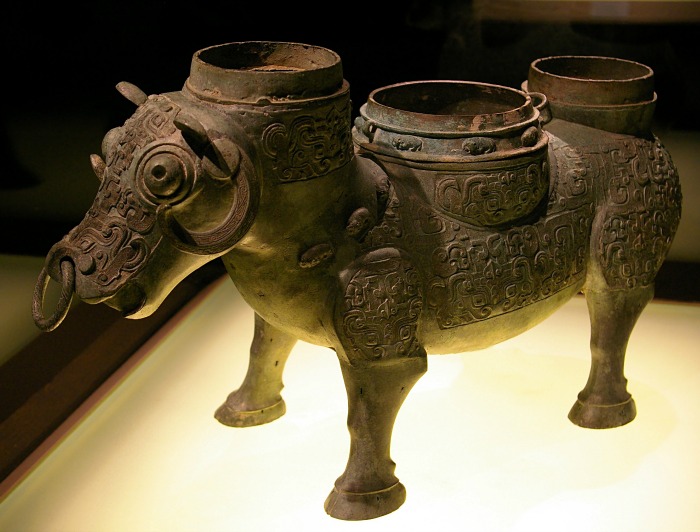
Chinese Bronze Zoomorphic Designs
There are a couple things that make these bronze vessels unique and fun to look at. The first is the designs on the outside of the vessels.

These designs, similar to the early pottery above, are zoomorphic designs, which means they are animal designs, but they are abstract. They’re really interesting and intricate, and you have to really look to find the animal hidden in the abstract designs. These animals took on a symbolic nature, and they represented stories and symbols. The qualities of these animals might transfer to the family or the ancestor of the person who owned the vessel. The vessels were either in a spouted shape, a round shape, or a square shape and often they would be in the shape of the animal itself, with more animal designs on the outside.

One of the most popular designs on the outside was called a taotie, which was a kind of a squished mythological animal. The taotie is like a mask. It doesn’t often include the body. If you imagine, if you take an animal from the front and squish it into the side of the surface. You’ve got the eyes and then the face and then the the rest of the features sort of coming out of the side as they get squished.
A taotie is like a monster on the side of this vessel, and he’s trying to get you. He’s trying to eat you and harm you, but he’s trapped.
Chinese Bronze Vessel Discussion Questions
Show a Chinese Bronze Vessel and ask the following questions.
- What do you see?
- Describe this artwork? Describe the lines, designs, etc.
- What images can you find? What animals can you find?
- Why do you you think these animals were included in the artwork?
- What do you think these animals might symbolize?
- What do you think this was used for? What is the function of this artwork?
Learning Activities
Want to explore these artworks more with your students? Try these ideas.
- Print out pictures of different bronze vessels and have students practice finding and sketching the animal designs from the vessels.
- Give students a realistic photograph of an animal and have them try to make the animal abstract using the bronze vessels as inspiration.
- Have students take an animal, a mythological animal that they create, or a person and squish them forward onto the paper. Make a two-dimensional, abstract design that’s symmetrical like the taotie is on the side of these vessels.
- Take pictures of students with their face squished into a pane of glass. Then, have them draw themselves from prints of the pictures.
- Make your own clay vessels in animal shapes. Carve animal design into the sides.
- Make a symmetry monster-style artwork inspired by the Chinese taotie.

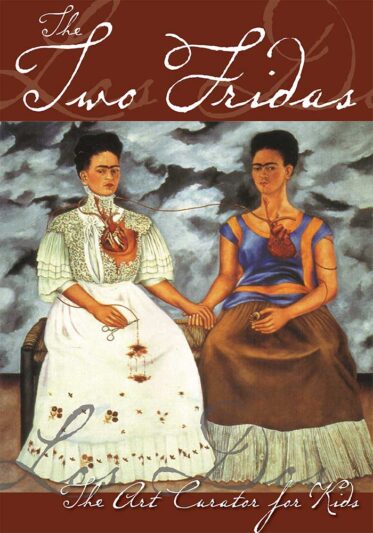



Very impressive write up. I can teach right from this page. Thank you very much for sharing your knowledge. I have taken some classes in this area but I do not remhember much.
Thank you! 🙂